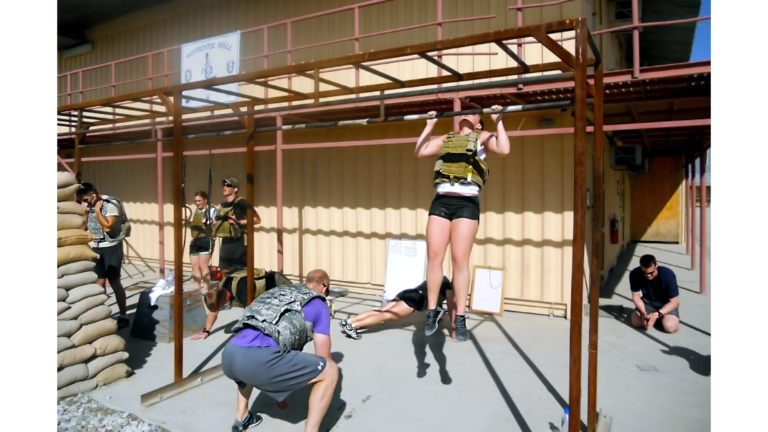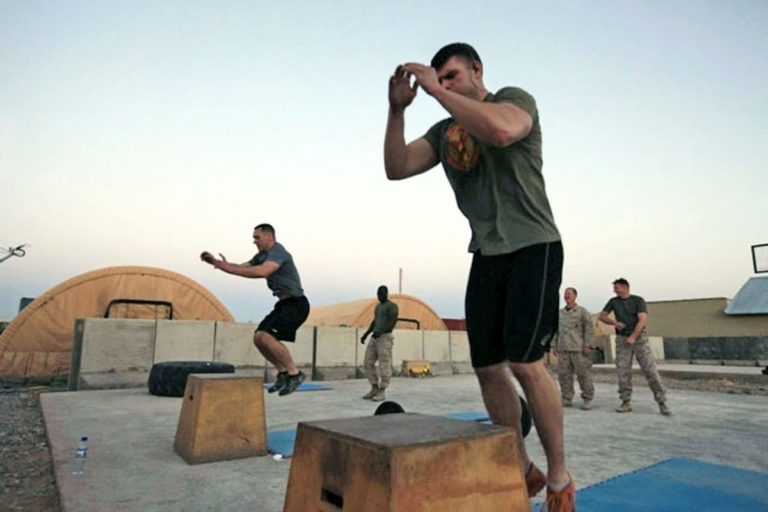The veteran athlete can be challenging and intimidating to coach. According to the 2018 Census, only 7 percent of the U.S. population has served in the Armed Forces, so when a veteran walks into your gym, how do you approach coaching them?
Every veteran is different — each has their own experiences and stories that built their service and made them who they are today. Those experiences, good and bad, will follow them for the rest of their lives, so it’s important that we as coaches know how to respect, guide, and help integrate these men and women into our communities.
Thank You for Your Service?
“Thank you for your service” is the default response when someone is introduced as a veteran. Some people may like and appreciate the sentiment, but for most veterans I know, the statement makes them feel awkward. It’s a hard statement to respond to, and “You’re welcome” in return feels uncomfortable. Instead, try: “I’m glad you’re home safe,” “I’m excited to have you as part of our community,” or just “Welcome home” can leave the door open for more genuine conversation.
Asking the Right Questions
 Most of the time when I have a veteran as an on-ramp client, I only find out about their service by asking them questions about their fitness or career background. Once the topic comes up, I like to know what branch they served in, if they’re still active, or how recently they transitioned out. Those factors help me introduce them to other veterans in the community; understand their current/past obligations; and understand where they are in their transition from their career of military service to veteran and civilian.
Most of the time when I have a veteran as an on-ramp client, I only find out about their service by asking them questions about their fitness or career background. Once the topic comes up, I like to know what branch they served in, if they’re still active, or how recently they transitioned out. Those factors help me introduce them to other veterans in the community; understand their current/past obligations; and understand where they are in their transition from their career of military service to veteran and civilian.
The transition out of the military can be the hardest part of service for some, and can lead to a dark, dangerous place. Many veterans feel lost post-military now that their daily lives are free from regiment and their closest brothers and sisters are no longer beside them. Their entire lives are uprooted and restarted, and without a strong support system, many turn inward and shut others out. Asking about their new life post-military helps us understand how we can best support them.
Once I know they’re comfortable discussing their service, I follow up by asking where they were stationed and what their MOS (Military Occupational Specialty) was. Chances are, you can start a meaningful conversation from one of these points, and start bridging the gap between veteran and civilian.
Not All Wounds Are Visible
As always, ask your athletes if there are any injuries or limitations you should know about as a coach — but understand that you may not get all of the details immediately. Injuries may not be as obvious as amputations and prosthetics; there can be traumatic muscle and brain injuries that need just as much skilled coaching.
The Adaptive Training Academy (ATA) is a great resource for scaling and progressions for all types of needs. Every skill in CrossFit can be adapted to the athlete’s ability, and the ATA has resources that can be a huge help. Check their Instagram account for tips, and check out their certification courses for CEUs.
Traumatic brain injury (TBI) can impact athletes in a variety of ways. They may need simpler cues that are easier to remember, or reminders during the WOD of what their movements are and how to move through them. They may even benefit from simplified WODs, spending a time domain on each movement, or even a simplified rep scheme to help keep things manageable. Check in early and often during the warm-up and the WOD to make sure they’re feeling good and on track. Watch for signs of dizziness from vestibular triggering in movements such as burpees, wall-ball shots, or sit-ups — try mountain climbers, dumbbell push presses, or flutter kicks as alternatives.
Scaling Might Be Hard on the Ego
 Telling a veteran they need to scale and them listening to you are two totally different challenges. For most people walking into CrossFit, working up to the hardest stuff is a rational, believable method. But for veterans, they’ve already done the hard stuff, so how is this going to be harder? Seeing kipping and butterfly pull-ups for the first time brings out mixed emotions in new people, especially if they’ve only ever been exposed to strict pull ups. For the eager newcomer, relying on the “strict before kipping” rule is the safest and easiest example to explain why scaling progressions work.
Telling a veteran they need to scale and them listening to you are two totally different challenges. For most people walking into CrossFit, working up to the hardest stuff is a rational, believable method. But for veterans, they’ve already done the hard stuff, so how is this going to be harder? Seeing kipping and butterfly pull-ups for the first time brings out mixed emotions in new people, especially if they’ve only ever been exposed to strict pull ups. For the eager newcomer, relying on the “strict before kipping” rule is the safest and easiest example to explain why scaling progressions work.
Give Them a Mission, Purpose, and Camaraderie
Veterans choose to join the military for thousands of reasons, but one thing they all have in common is a servant’s heart. They are the ones called on in the darkest times and in the hardest situations, and they may crave that feeling of purpose once they’re out of the military.
Give them a goal: “Your goal in today’s WOD is …”
We all know the feeling of hitting a PR — pride, excitement, encouragement. In every WOD, give your veteran athletes something to achieve, so even if that’s all they achieved that day, they’ve completed their mission.
Support their skills/services.
Find out what they do professionally and support them. Ask them for help with projects or advice in their specialties. Give their new life and new profession a tangible meaning.
Lighten their load.
Give them a place to feel safe, appreciated, and encouraged. Listen when they’re willing to talk, express to them the difference they make in your community, and cheer them on. The sweat and struggle during the WOD is the obvious part, but community is what makes CrossFit a safe place for all walks of life, including those who may be struggling.
As with any demographic, veterans are not one-size-fits-all athletes when it comes to coaching. This is where your people skills have a chance to shine. Take the time to get to know your veteran athletes and welcome them to your community — you have a chance to make a huge difference in not only their lives, but also in everyone else’s that they touch.
About the Author
HaLeigh Abbott is a Level 2 CrossFit Trainer at CrossFit Thunder Hill in Oxford, Pennsylvania, a veteran spouse, and the Marketing Chair for The Weekly Fight, a 501c3 nonprofit dedicated to bridging the gap between the veteran and civilian communities. Through free weekly workouts at their partner gyms, The Weekly Fight is determined to turn post-traumatic stress into post-traumatic growth through healthy alternatives and community. To learn more, visit The Weekly Fight on socials and at theweeklyfight.org.